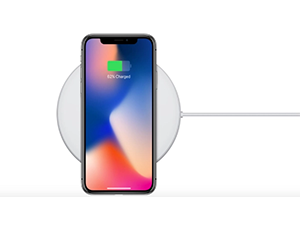Apple’s wireless iPhone charging is nothing new, and that’s great news for all of us.
When Apple announced its new line of iPhones, one of their highlighted features was “wireless charging.” The reaction from many reviewers was something along the lines of, “it’s about time,” meaning it’s a feature that Apple has been missing out on. Not integrating new technologies early on is something Apple users should be used to by now. After all, Apple waited for OLED technology to get sufficiently advanced before they put it in a smartphone, and they waited until they could develop incredibly accurate infrared depth mapping facial recognition before “FaceID.” But when was the last time Apple adopted a normal charger? Apple’s laptops have traditionally used their own Magsafe chargers (recently switching to USB C connectors), 30-pin connectors were used in iPods and iPhones, and lightning connectors are still in use. These cables cannot be used with anything but Apple products. This is why Qi (pronounced “chee”) is a big deal: it gives us an opportunity to make public charging a real thing.
Qi (from the Chinese word chi, meaning “energy flow”) is an open interface standard that defines wireless power transfer using inductive charging. It lets you simply lay the back of your mobile phone down on the charging pad (which is plugged into a power source) to charge it, versus having to plug a charging cable into the phone.
The Wireless Power Consortium, a multinational organization based out of New Jersey, has the support of over 250 companies to back the Qi wireless charging standard. This means that companies like Verizon, Samsung, Nokia, and now Apple are in good company for a wireless charging solution that is sure to be supported in the future. But the support from so many companies doesn’t mean anything if Qi wireless chargers aren’t available in public or from third-party vendors at a reasonable price.
They’re available in public
Verizon has installed 800 Qi-enabled charging spots for smartphones in major US airports. This was a smart move, as many of us have lamented the times we didn’t bring a charger on flights with a layover. Other spots around the world are trying this Qi integration as well, like McDonald’s restaurants in Hannover Germany, or cafes in Toronto like Coffee Bar Inc., Sense Appeal, Thor, and Balzacs. These seem like small steps for such major companies, but now that the top two global smartphone makers, Samsung and Apple, support Qi charging, more businesses will undoubtedly want to expand this effort, as these two smartphone brands make up 42% of total global smartphone ownership. Of course public access is great, but you’ll probably want to get this in your home and it also has to look good.
You can get it in your home and it looks good
Major companies like Aukey, Anker, and Belkin are all making affordable units for wireless charging, but they don’t seem that imaginative. They’re all small black plastic discs that cost $20-$30. This might be fine if you want to set up something on your office desk, or if this happens to go with your home’s decor, but if you want something that blends in a little better and looks good doing it, Ikea is doing some great stuff.
Ikea ran an ad campaign for their Qi chargers after the Apple announcement of the iPhone 8 and X. These ads included pictures of their modern desk lamps with tag lines including “this charges everything,” “link different,” and “one more thing… it’s also a lamp.” These are references to Apple’s slogans “this changes everything,” “think different,” and “one more thing… it’s also a phone.” So why did Ikea feature a lamp in these advertisements? Ikea has made a few desk and floor lamps that feature Qi chargers built into the base. This is a pretty elegant solution, as most people will have a lamp on their desk and would want to charge their phone there anyways. The charge area is marked with a plus symbol, indicating that the lamp can charge a phone. There is also a nightstand, single and triple wireless charging pads with wood borders, and even a charging solution for your current desk if you care to drill a 78mm-diameter hole in your desk.
Should I buy one of these wireless chargers?
If you have a Samsung phone that supports wireless charging or are planning on getting one of Apple’s newest phones, then it is a convenience. Being able to put a couple of these chargers down in the house without drawing attention to them and not fumbling for the “right” cable for your particular phone is pretty handy. There’s no doubt that more public locations and businesses will be making Qi chargers available for use in their establishments soon, as convenient and inexpensive as they are. Just keep an eye out for that little plus symbol on the table in a hotel room, a fast food restaurant, or in your favorite cafe over the next few years.
If you have any questions about wireless charging or would like a hand implementing wireless charging solutions for your home or business, please give us a call or email us, and we’ll be happy to assist.


